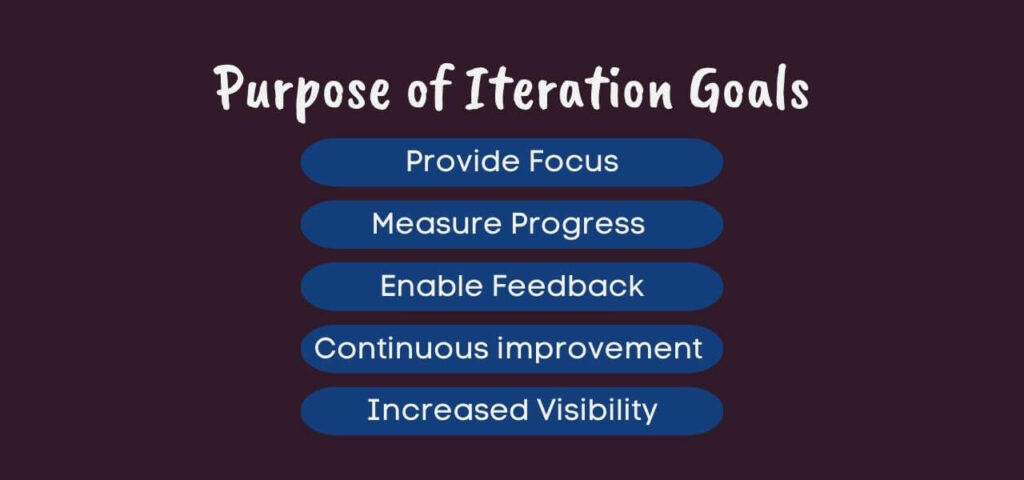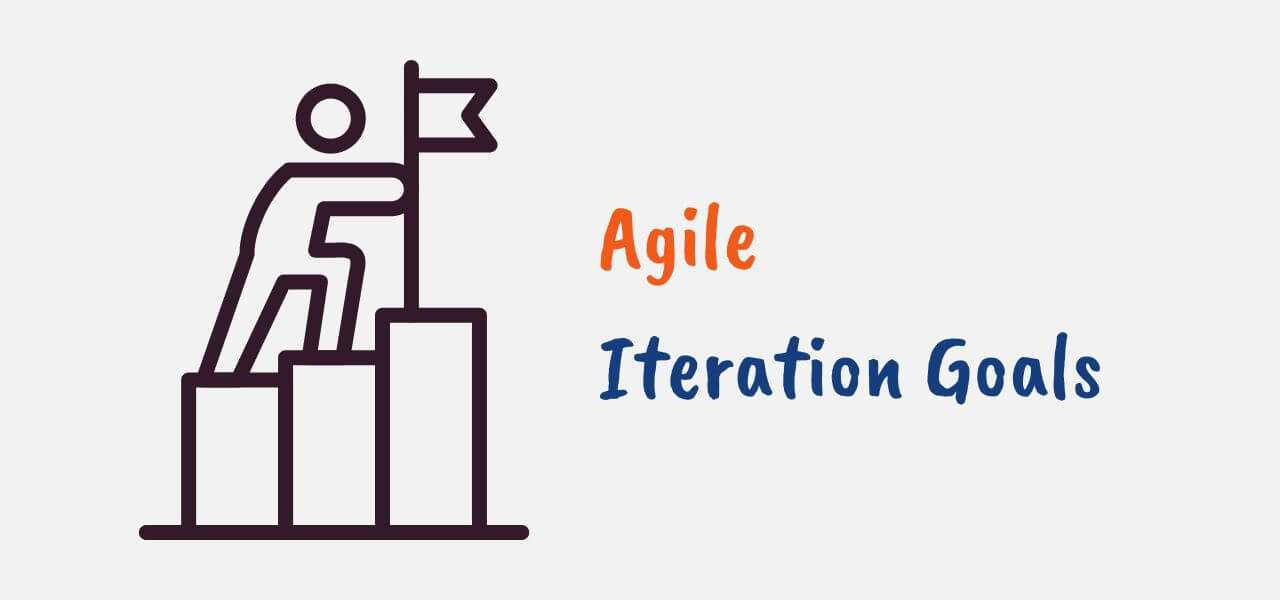As a project manager or software developer using Agile, you will constantly iterate. You will iterate on features, product designs, code, and on processes.
But without proper planning and iteration goals, these iterations feel aimless and meaningless. So what is the purpose of iteration goals?
In this post, we will answer this question, and also explore how to define effective iteration goals, choose goals that support your project’s key metrics, and how to evaluate whether your iteration goals were achieved.
What are Iterations Goals?
Iteration goals are objectives set for each iteration (such as a sprint) in an Agile software development process.
The core idea behind Agile is to work in short bursts of focused effort. These short durations of work are called iterations.
Each iteration has a clear set of goals to achieve. At the end of the iteration, teams review progress, adapt plans, and set new goals.
Iteration goals keep teams accountable and aligned and provide guidance for the team to work together efficiently while ensuring flexibility to adapt to change.
The iteration goals should be specific and measurable, focusing on business and customer value. They answer questions like ‘What can be delivered’ and ‘How will we know we’re done?’.
Iteration goals keep teams motivated and progressing in the right direction. They are a key reason why Agile works.

Examples of Iteration Goals
Some examples of good iteration goals are:
- Improve login page functionality
- Build API for customer search
- Increase the performance of the recommendation engine by 20%
- Implement the login feature for a web application
- Improve the performance of a specific algorithm
- Fix a set of critical bugs

What is the Purpose of Iteration Goals?
Iteration goals are a key part of an effective Agile planning and delivery process. They provide focus, enable measurement of progress, facilitate feedback and continuous improvement, and increase visibility for stakeholders.
Some of the key purposes of iteration goals are:
1. Provide Focus
The iteration goals help the team focus their efforts on the most important things that need to be accomplished in that iteration ensuring that they avoid wasting time or working on less important things.
2. Measure Progress
By setting concrete goals for each iteration, the team has a set of targets to work towards and measure their progress against.
This way, the team is on track to complete all the planned work in the iteration.
3. Enable Feedback
Concrete goals also make it easier for stakeholders to provide feedback on the work completed in each iteration by acting as a framework for discussing what was achieved and not achieved.
4. Continuous improvement
Reviewing the team’s success in achieving the iteration goals helps identify areas for improvement. The team can then put steps in place to improve for the next iteration.
5. Increased Visibility
Clearly communicating the iteration goals to stakeholders helps increase visibility into what the team is working on and aiming to achieve.
This transparency and visibility builds trust and confidence in the team.
Setting Effective Iteration Goals
To set effective iteration goals, consider the following tips:
- Align with project vision: Ensure that iteration goals contribute to the overall project vision and objectives.
- Make them SMART: Goals should be Specific, Measurable, Achievable, Relevant, and Time-bound.
- Involve the team: Encourage team members to participate in setting goals, as they have valuable insights and can contribute to more realistic and achievable objectives.
- Keep them concise: A concise goal is easier to understand, remember, and communicate with the team.
Common Mistakes When Setting Iterations Goals
If your iteration goals have to achieve their purpose, then they need to be set right. Some common mistakes teams make when setting iteration goals include:
- Not making the goals specific enough: Goals should be concrete and measurable, not vague or ambiguous.
“Improve user experience” is not a good goal.
“Reduce login error rate by 50%” is better. - Not prioritizing the goals: Teams often set too many goals for an iteration, without determining which are most important. Focus on the high-priority goals first.
- Not sizing the goals realistically: Teams often overestimate how much they can achieve in an iteration. Goals should be based on actual team capacity and velocity.
- Not linking goals to product vision or roadmap: Goals should drive teams toward the overall vision and priorities, not just represent a random to-do list.
- Not reviewing goals frequently enough: Teams should evaluate progress towards the goals often, to ensure they are still relevant and adjust as needed. Waiting until the end of the iteration is too late.
- Setting “solution goals” rather than “problem goals”: Goals should represent business or customer needs, not predetermined solutions. Focus on the problem, not the solution.
- Not making goals measurable: If you can’t determine whether a goal was achieved or not, it’s not a good goal. There must be concrete metrics or evaluations that can measure success.
- Not using goals to drive learning: In addition to tracking progress, goals should be used to determine what’s working, what’s not working, and where improvements can be made for future iterations.
- Not linking individual and team goals: Goals at the individual level should support overarching team and organizational goals. Make the connection between the two clear to everyone.
- Failing to communicate the goals to all stakeholders: If people don’t know the goals, they can’t work to achieve them and provide meaningful feedback. Share the iteration goals broadly!
Monitoring and Adjusting Iteration Goals
Once the iteration goals are set, it’s essential to monitor progress and adjust as needed. Here are some steps to manage iteration goals effectively:
- Track progress: Regularly assess the team’s progress towards achieving the iteration goal. Tools like task boards, burndown charts, and daily stand-ups can help with tracking.
- Review goals: At the end of each iteration, conduct a retrospective to review the goals and evaluate the team’s performance. Identify any obstacles and discuss ways to overcome them in the next iteration.
- Adjust goals: If necessary, adjust the iteration goals based on changing requirements, feedback, or team capacity. Ensure that the goals remain relevant and aligned with the project’s overall vision.
Measuring the Success of Iteration Goals
When you set out goals, you need to be able to know whether you are meeting or have met these days after a certain period of time.
To do this, your goals have to have certain metrics that you can compare your results against and evaluate whether they meet up.
Some common metrics used to measure the success of iteration goals include:
- Completion rate: The percentage of planned goals that were fully achieved. A high completion rate indicates effective planning and estimation.
- Error/defect rate: The number of errors, bugs, or defects reported. A decreasing error rate shows increasing quality and progress.
- Customer satisfaction: Feedback from customers or users on the new features or work completed. Positive feedback and reviews indicate the work is meeting customer needs.
- Task estimation accuracy: A comparison of estimated vs actual hours required to complete tasks. Improving estimation accuracy shows the team is learning and planning more effectively.
- Team productivity: A measurement of the amount of work completed per iteration. Increasing productivity over time shows improving team skills, processes, and ability to meet commitments.
- Request closure rate: The percentage of requests, bugs, or tasks closed vs opened each iteration. A closure rate of over 100% indicates the team is proactively reducing work in progress and tackling issues efficiently.
- Lead time: The average time required to fulfil a request or close a bug/task. Decreasing lead times demonstrate superior responsiveness and process optimization.
- Velocity: The amount of work completed per iteration. An increasing velocity trend shows a team that is constantly improving and able to complete more work within the same constraints.
- Client satisfaction: Regular feedback surveys from primary stakeholders. Improving satisfaction scores indicate better alignment between delivered work and client priorities or needs.
- Team satisfaction: Regular surveys of the team members themselves. High or improving team morale and satisfaction means a productive team that is meeting goals and able to work together cohesively.
- Cost/Schedule performance: A comparison of planned budget, hours and due dates versus actuals. On-track performance indicates reliable planning and delivery, while deviations signal areas for improvement
Conclusion
Iteration goals are vital components of Agile project management. They provide direction, focus, and motivation to teams while facilitating collaboration and accountability.
By setting clear, SMART iteration goals that align with the project vision, teams can effectively prioritize tasks and manage their time and resources.
Monitoring progress and adjusting goals as needed ensures that your team remains agile and responsive to changing requirements, ultimately leading to project success.





